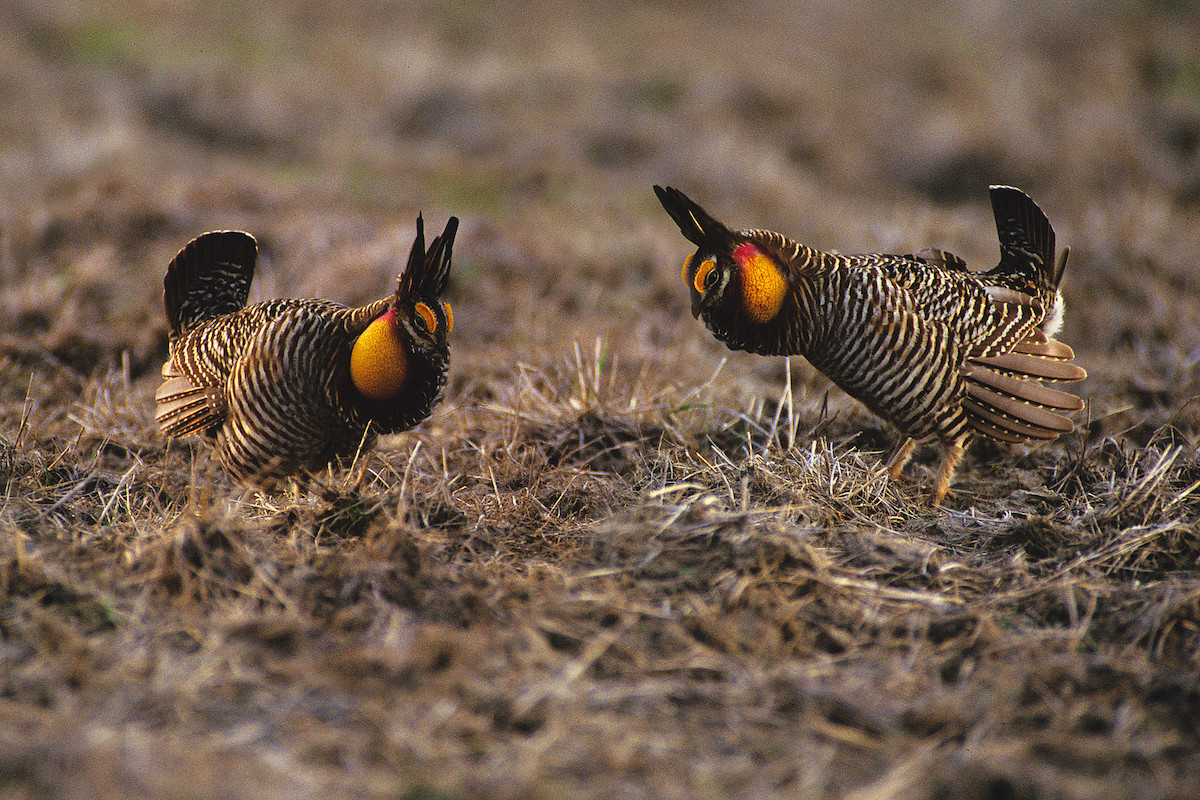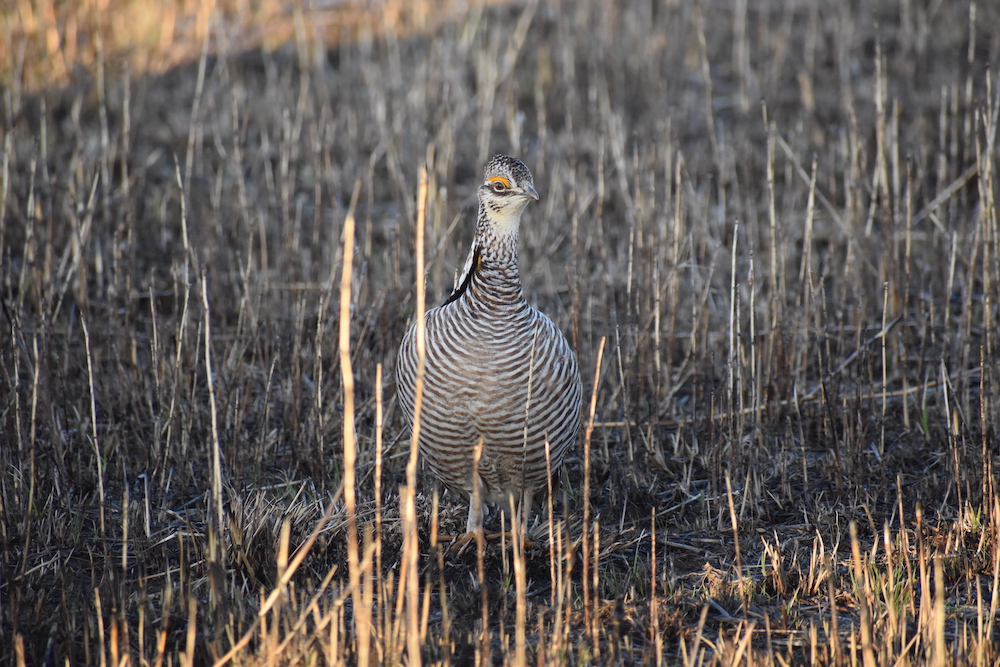Photo by Michael R. Jeffords.


Status of the Greater Prairie-Chicken in Illinois

There is a certain period in the spring when the last frost advisories are announced, Tax Day has passed us by, planting season begins in earnest, and the greater prairie-chicken males begin to reluctantly diminish in their spring courtship displays.
In Illinois, data has shown that female greater prairie-chickens visit the booming grounds in the highest numbers close to the tenth of April, the peak of breeding in our state. This year was no different. I was sitting in the blind with a group from Indiana Audubon on April 10 and it was a morning of glory for our greater prairie-chicken males—a still frosty spring morning of record if there ever was. The males were joined by the hens on the booming ground. That morning on the McCormick Corral lek we had 14 males and 9 hens that had a particular goal in mind. There was much booming, “Whooping,” flutter jumping, nuptial bowing, and successful breeding events.

The tell-a-tale feather ruffling by a hen often suggests that a successful copulation has occurred and that the breeding season is done for that individual hen. Laying eggs will be the next project on her job list. A mated hen typically does not return to the booming ground unless she loses a first nest attempt.
As hens mate and leave to initiate nesting, little by little the booming ground gets less active, the males’ morning display shortens in duration and the “boys” just don’t put as much into it. If the hens aren’t going to attend the lek why waste good feeding and loafing time for displaying and battling? Male prairie-chickens attend the booming ground all spring with some of the first activity happening in the dead of winter—males may visit the lek in February to start to stake their territorial claims on the booming ground. It is all energetically taxing.
As the hens develop their nests and the males give up the spring struggle, observant birders and biologists try to determine the number of males per booming ground. “How many birds do we have? How many males did you observe here and there? Do you think those males are trading back and forth in that geography? Where is that juvenile male being chased off to; does he occupy the Ochs Hill lek after he’s bumped off the McCormick?” It can be a moving target sometimes to elucidate an accurate census and generally requires early mornings, on repeat, on various leks, all spring—by some dedicated ecologists.
I always think back to what it must have been like to census prairie-chicken booming grounds back when the birds were more plentiful. Imagine riding with famed ecologist Aldo Leopold in 1929 when he surveyed chickens in Illinois and Indiana. Or maybe sit in a blind with Frederick and Frances Hamerstrom. The things one could have learned about prairie-chickens and grassland owls! Just think of the ecologists who have come before to peer through field glasses and spotting scopes, in some cases to view the very booming grounds we still maintain and survey today. To visit with John Toepfer and Ron Westemeier and Ralph E. Yeatter. “Fellas, would you reseed this meadow? Is there too much tallgrass in this unit? What do you think of these wetter springs; are they just cyclic?” I marvel as you can tell, sometimes.

Then practicality enters the office. On the Jasper County unit of Prairie Ridge State Natural Area this spring it appears that we currently support on the order of 52 male greater prairie-chickens. Marion County supports approximately 18 males. We consider a 50:50 sex ratio and therefore estimate hen numbers to closely match the number of males on the landscape at any given time. The Marion County population is tenuous. This spring we anticipated it would be so and aggressively surveyed the Marion County unit to develop the most accurate picture of the population there. Recent habitat loss has dealt a heavy hammer blow to this landscape as have the contemporary ill-timed wetter weather conditions. Jasper County has fared better, following the translocations of birds in 2014, 2016 and 2017, with an uptick in bird numbers from a precipitous low of 12 males in 2014.
As I write this, the hens are building their clutches. It is my hope (and the hope of many that “Whoop!” with optimism for prairie chickens) that the weather cooperates, and the grasslands provide.
Bob Gillespie is the site manager at Prairie Ridge State Natural Area in Jasper and Marion counties.
Submit a question for the author
Question: Are there any workdays planned for brush clearing, prescribed burns, or similar volunteer activities?
Thank you.
Question: My wife and 10 year old daughter Sinshine went to a blind with a ranger to observe the chickens in about 1987 we still talk about it. Thanks for the opportunity
Question: Hi Bob – I’m a life long student of the grasslands & ag fields here in northern Illinois – I graduated from NIU in 1983. My question has to do with the dwindling populations of Bobwhite, Pheasants and of course Prairie Chickens. Specifically, what can be done and what’s being considered about coyotes, raccoons & other ground dwelling predators that devastate these populations? I’m frustrated by it and seeking an answer. If there are opportunities to volunteer my time – please notify me. Thank you – Sincerely Mike
Question: Have there been (or will there be) any attempts to reintroduce the Prairie Chicken into spots like Nachusa Grasslands or Midewin National Tallgrass Prairie?
Subscribe to our Newsletter
Explore Our Family of Websites
Similar Reads
She Finds Rare Prairie Clover – Missing Since 1873
November 3, 2025 by Stephen Packard
Snake Fungal Disease Imperils Illinois’ Smallest Rattlesnake
November 3, 2025 by Hugh Gabriel
Determining the Threat of Local Extirpations for Illinois’ Rare Plants
November 3, 2025 by Brian Charles, Paul Marcum, Greg Spyreas, Eric Ulaszek, David Zaya, Brenda Molano-Flores
The 2025-2026 Upland Hunting Forecast
November 3, 2025 by Don Kahl
Appreciating the Understated Beauty of Native Grasses
November 3, 2025 by Sima Shah
Remembering John L. Roseberry
November 3, 2025 by John Cole
Nature’s Seasonal Events
November 3, 2025 by Carla Rich Montez
Everyone Poops: The role of Canada geese in transporting bacterial communities
November 3, 2025 by Auriel M. V. Fournier
Return of the Giants: The reintroduction of alligator gar to the Cache River
November 3, 2025 by Mark Denzer, Rob Hilsabeck
Public Lands Dedicated to Illinois’ Hunting Heritage for a Century
November 3, 2025 by Kathy Andrews Wright